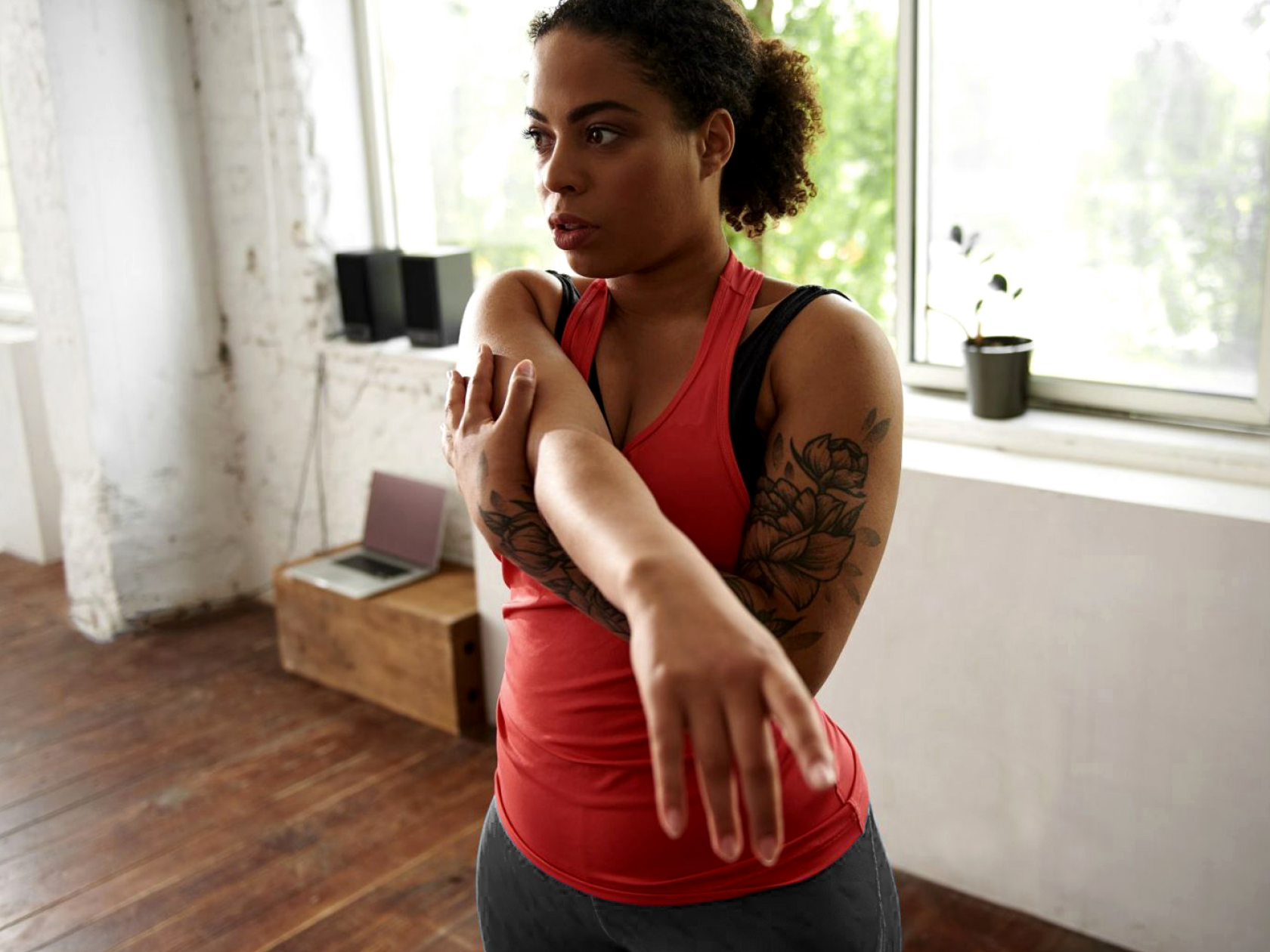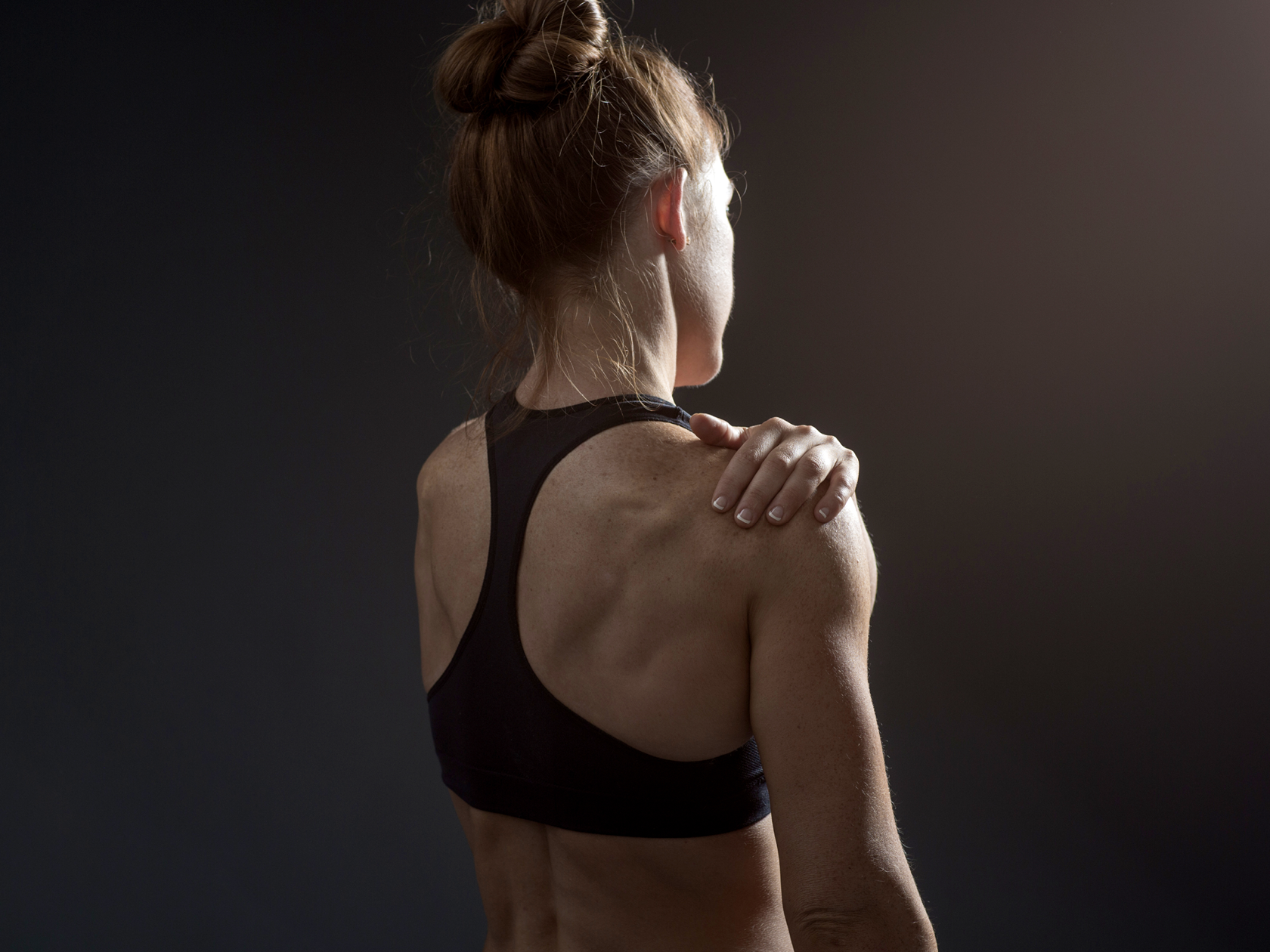Struggling with aches and pains? These exercises could sort you out.
It’s no secret that exercise is great for you, both mentally and physically. So, whether you tend to go hard at the gym, like to take to the pavements for a brisk walk at the end of a long day at your desk, or have your favourite home workouts, you can be sure you’ll be getting a whole heap of benefits.
But exercise isn’t without risk, and there is always a chance you could tweak something here or pull something there. If you do find yourself with a mild injury, though, there are stretches and exercises you can do to help ease the issue and work your way back up to your normal exercise routine.
We asked a sports therapist and a physiotherapist for some of the most common sports-related injuries people come to them with, from neck stiffness to runner’s knee, and the exercises they might use to treat these issues. However, remember to always consult your doctor first if you have an injury, and to always make sure you get anything serious seen to as soon as possible.
You may also like
Stretching: support muscle recovery and avoid injury with these postures
What are some of the most common lower body injuries people come to you with?
Tamara Tarr, qualified Sports Therapist and Flexpert at Flexology Studio
“One common lower body injury is runner’s knee, which clients describe as a pain under and in the area of the kneecap. It usually develops during physical activity, but even long periods of sitting can cause pain. Even though it’s called runner’s knee, it’s not just runners who are affected by it. Basketball, netball and volleyball players are also affected due to the amount of jumping involved in those sports, as are footballers.
“Exercises I suggest for clients suffering with runner’s knee are squats, single leg squats and lunges. These will all strengthen the quadriceps, and this is needed to minimise the pressure on the kneecap.”
Kathryn Tilbury, Physiotherapist at Third Space Sports Medicine in Canary Wharf
“I see a lot of hip tendinopathy. It’s an overuse injury that affects the outer part of the hip, often caused by a sharp increase in volume of intensity of exercise. It is common in runners and those who do activities such as HIIT or other exercises classes.

“This can be a tricky injury, especially for highly motivated gym-goers, as it requires abstaining from aggravating activities until symptoms settle a bit. Initially, I’ll focus on working the deep gluteal muscles by doing straight leg abduction exercises, which entail moving the leg to the side and slightly backwards. These muscles help to support the hips, especially in single leg activities.”
What are some of the most common back injuries people come to you with?
Tamara Tarr
“The most common back injury that clients come to me with is lower back pain. This is usually due to poor posture and heavy lifting. It can also be due to a lack of mobility in the glutes and hamstrings, so I like to suggest to anyone suffering with lower back pain that they regularly stretch these areas.
“As well as stretching, an exercise that is really effective in strengthening the lower back is deadlifts.”
You may also like
Which muscles do deadlifts work? Fitness trainers answer your most googled questions
Kathryn Tilbury
“Back injuries are incredibly varied. Often pain and injuries can occur because of a lack of movement, and sometimes it is because of too much movement or poor lifting techniques. They are often attributed to a disc bulge or herniation, however not all back injuries are to do with the discs. They can occur to the many structures of the spine, including the bones, ligaments, nerves and muscle tissue, and sometimes we can have pain with no presence of structural compromise at all.
“Treatment is dependent on how a person presents and what their current activity levels are. A good place to start is with spinal mobilisations on all fours, with the cat/cow exercise and moving the hips from left to right. Initially, if someone is very uncomfortable, I advise them to do small movements. The back often gets quite stiff when it’s injured, so gentle movement throughout the day is the most common advice I give in the early stages of treatment.”
What are some of the most common shoulder injuries people come to you with?
Tamara Tarr
“The most common shoulder injury that I see is shoulder impingement. Clients will complain that they are struggling to lift their arm up, even to brush their hair or put on a jacket. It can also affect their sleep due to constant aching. If you are suffering with this you will need to book an appointment with a therapist to receive treatment.

“Once pain has started to decrease, I like to suggest exercises such as high to low rows and external and internal rotation strengthening, all using resistance bands.”
Kathryn Tilbury
“Shoulder injuries that we see a lot of in the clinic are overuse injuries, which we cluster together under the umbrella term of rotator cuff related shoulder pain. Sometimes this occurs because the rotator muscles are not as strong as they need to be to support our everyday movements. I would recommend focussing on strengthening the rotator cuff muscles, which work together to help stabilise the shoulder joint when you move your arms.
An exercise I use frequently for this type of injury comes from physiotherapist Jeremy Lewis’ Shoulder Symptom Modification Procedure. Place a theraband around the back of both hands and push the band outwards. Keep your arms straight to lift them in front of you and, if you can, above your head. This helps to activate the rotator cuff muscles, thus supporting movement and reducing symptoms.”
You may also like
Shoulder workout: get strong deltoids with this resistance band circuit
What are some of the most common neck injuries people come to you with?
Tamara Tarr
“The majority of clients who have neck injuries complain of pain when moving the neck, so they struggle to turn their head to look up, down, left, or right. But this is usually due to long periods of looking down either at a laptop or smartphone, rather than anything sports-related. This causes the trapezius muscle (traps) to tighten, which is why you will experience pain at the back of the neck.
“An exercise I suggest to clients who suffer with neck pain is neck circles, which they should do regularly when working for long periods at a desk. This will help prevent the neck from getting stuck in one position.”

Kathryn Tilbury
“Commonly people come in with neck pain that is attributed to not moving enough throughout the day and sitting at a desk for sustained periods of time.
“I use an exercise to activate the deep cervical neck flexors. Start lying on your back with your head resting comfortably, then very gently tilt the chin down and gently press the head back into the ground. This is a very subtle movement, using about 10-15% of what you could maximally do. It is the reverse of the position we hold our head and neck in when we work at a computer or watch something on our phones.
“Another exercise I like is prone cobra. Start lying on your front with your arms by your side and palms face down. Lift the head, shoulders and top of the chest off the ground, lift your hands and arms, and rotate the palms to face outwards by pulling the shoulders back to open the chest. Look straight down to the ground. This exercise works the neck and upper back muscles together, so you get more bang for your buck.”
You may also like
5 shoulder and neck stretches for when you've been staring at a screen all day
Are there any other common treatment options for mild injuries?
Tamara Tarr
“If you have swelling or inflammation, it’s a good idea to elevate the limb, ice the area for up to 10 minutes at a time, and take painkillers like ibuprofen. For injuries such as sprains and strains, it is recommended that you rest until the pain has decreased. When the strain is mild, this often takes between a week and 14 days.
“Assisted stretching helps to relieve tight and sore muscles that often come from playing sports. You can book an assisted stretch with a sports therapist like myself, and ensure you see a therapist for any injuries, particularly persistent or severe ones.”
Kathryn Tilbury
“It’s important to note that rehabilitation from injury is much more than just one set of exercises, especially if you like weightlifting or recreational sports. Timely exercise progression to help the muscles tolerate more load and stress is an important part of a successful recovery.

“For common treatment methods, we use the acronyms PEACE and LOVE. In the early stages of recovery, it is recommended that you protect, elevate, avoid anti-inflammatories (because they are thought to slow down the initial and essential inflammation process), compress, and make sure you are educated on how to manage your condition. In the later stages, it is advised you load as tolerated, practise optimism, do cardio workouts to increase blood flow (known as vascularisation), and follow exercise prescription. I would always recommend doing this under the guidance of a suitable medical professional or therapist.”
Follow @StrongWomenUK on Instagram for the latest workouts, delicious recipes and motivation from your favourite fitness experts.
Images: Getty, Flexology Studio
Source: Read Full Article
